Names of platoons in the army. Organizational structure of the Armed Forces. Types of Armed Forces
The Russian Armed Forces have a three-service structure, which is more in line with today's requirements and makes it possible to increase the effectiveness of combat use, seriously simplify the interaction of various branches of the Armed Forces, and reduce the cost of the command and control system.

At present, the Armed Forces structurally include three types: the Ground Forces, the Air Force, the Navy; three types of troops Strategic Missile Forces space troops, Airborne troops, as well as troops that are not part of the types of the Armed Forces, the rear of the Armed Forces of the Russian Federation, organizations and military units for the construction and quartering of troops.

Ground Forces As a branch of the Armed Forces of the Russian Federation, the Ground Forces are designed to conduct combat operations primarily on land. In terms of their combat capabilities, they are capable, in cooperation with other branches of the Armed Forces of the Russian Federation, to conduct an offensive in order to defeat the enemy grouping and seize its territory, deliver fire strikes to a great depth, repel the invasion of the enemy, his large airborne assault forces, firmly hold the occupied territories, areas and frontiers.
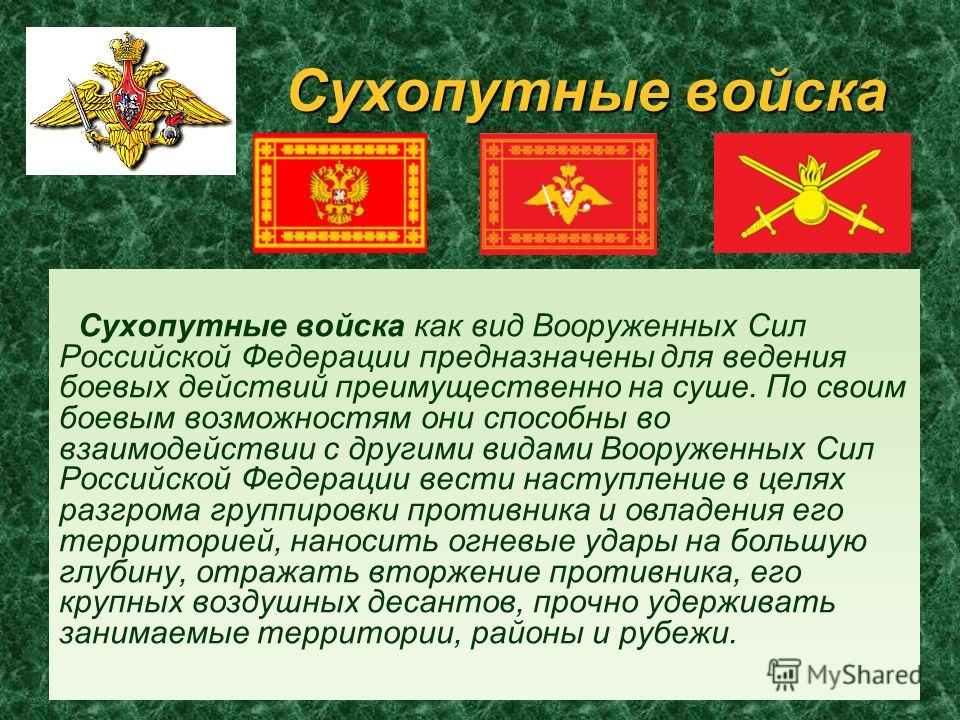
Compound ground forces The Ground Forces include: types of troops - motorized rifle, tank, missile troops and artillery, military air defense, army aviation; special troops (reconnaissance formations and units, communications, electronic warfare, engineering, radiation, chemical and biological protection, technical support, automobile and rear protection); military units and institutions of the rear.
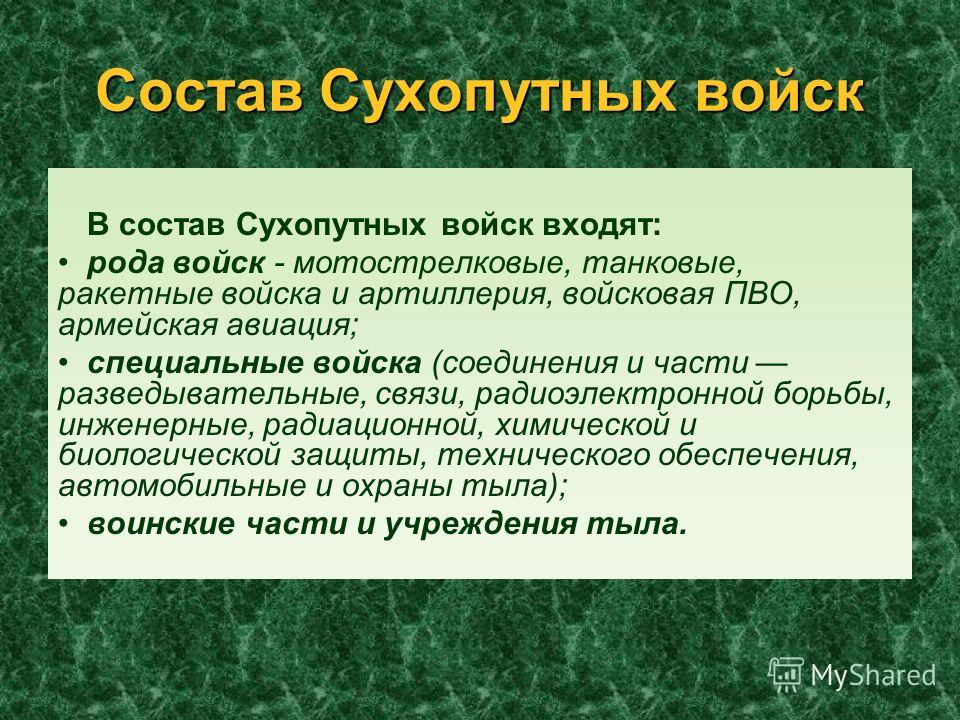
Motorized rifle troops the most numerous branch of the military, which forms the basis of the Ground Forces and the core of their battle formations. They are equipped with powerful weapons to destroy ground and air targets, missile systems, tanks, artillery and mortars, anti-tank guided missiles, anti-aircraft missile systems and installations, and effective means of reconnaissance and control. Tank troops are the main strike force of the Ground Forces and a powerful means of armed struggle designed to solve the most important tasks in various types of combat operations. Rocket troops and artillery are the main firepower and the most important operational means in solving combat missions to defeat enemy groupings.

Military air defense is one of the main means of defeating an air enemy. It consists of anti-aircraft missile, anti-aircraft artillery and radio engineering units and subunits. Army aviation is designed to act directly in the interests of combined arms formations, their aviation support, tactical air reconnaissance, tactical air assault landings and fire support for their operations, electronic warfare, setting minefields and other tasks. The successful fulfillment by the combined-arms formations of the tasks facing them is ensured by special troops (engineering, radiation, chemical and biological protection) and services (weapons, rear).
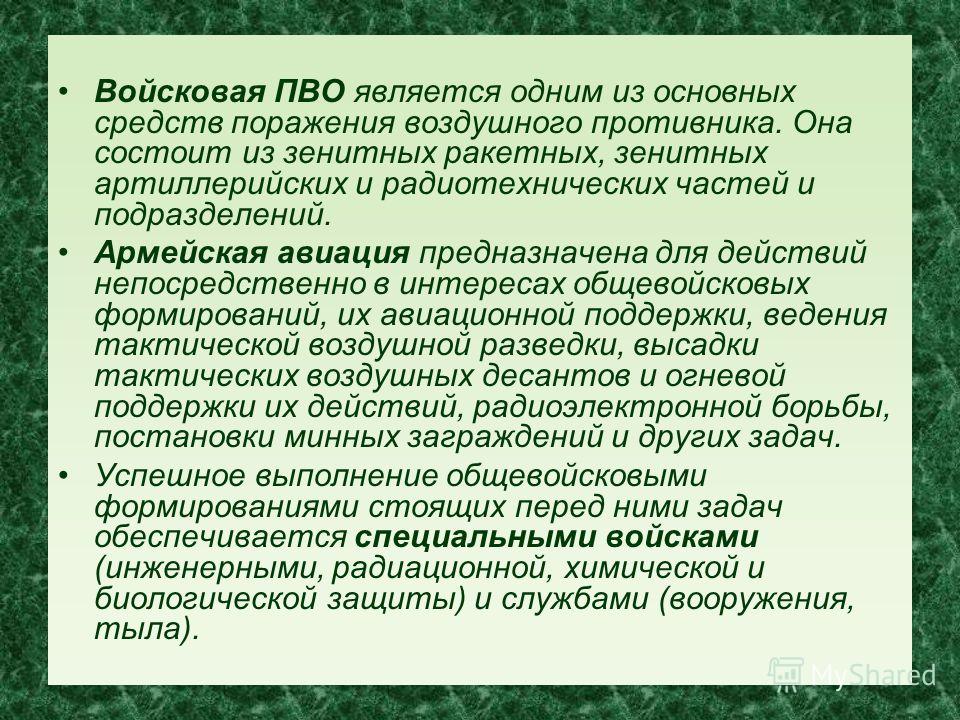
Organizational structure At present, the Ground Forces organizationally consist of: military districts (Moscow, Leningrad, North Caucasus, Volga-Ural, Siberian and Far Eastern), armies, army corps, motorized rifle (tank), artillery and machine gun-artillery divisions, fortified areas, brigades, individual military units, military institutions, enterprises and organizations.

The Air Force (Air Force) The Air Force is intended for: conducting reconnaissance of enemy groupings; ensuring the gain of dominance (deterrence) in the air; protection from air strikes of important military-economic regions (objects) of the country and groupings of troops; air attack warnings; destruction of objects that form the basis of the military and military-economic potential of the enemy; air support for ground and naval forces; airborne landings; transportation of troops and materiel by air.
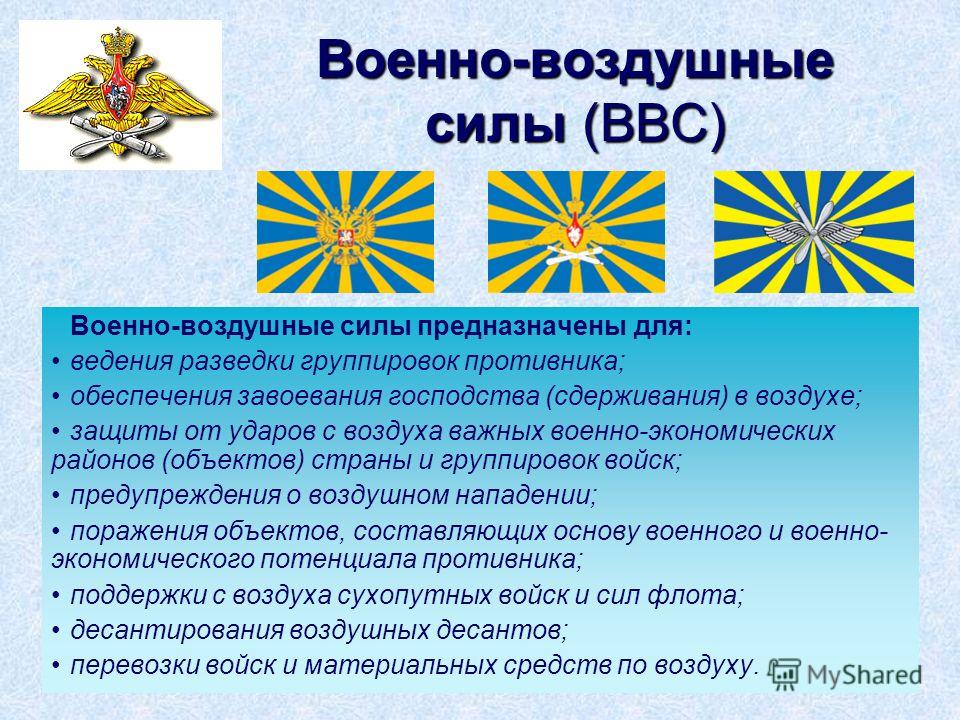
Composition of the Air Force The Air Force includes the following types of troops: aviation (types of aviation - bomber, attack, fighter air defense, reconnaissance, transport and special), anti-aircraft missile troops, radio engineering troops, special troops, rear units and institutions.

Bomber aviation is armed with long-range (strategic) and front-line (tactical) bombers of various types. It is designed to defeat groupings of troops, destroy important military, energy facilities and communication centers mainly in the strategic and operational depth of the enemy’s defense. The bomber can carry bombs of various calibers, both conventional and nuclear, as well as air-to-surface guided missiles. Assault aviation is intended for aviation support of troops, destruction of manpower and objects mainly on the front line, in the tactical and immediate operational depth of the enemy, as well as combating enemy aircraft in the air. One of the main requirements for an attack aircraft is the high accuracy of hitting ground targets. Armament: large-caliber guns, bombs, rockets.

Air defense fighter aviation is the main maneuvering force of the air defense system and is designed to cover the most important directions and objects from enemy air attacks. It is capable of destroying the enemy at maximum ranges from the defended objects. Air defense aviation is armed with air defense fighter aircraft, combat helicopters, special and transport aircraft and helicopters.

Reconnaissance aviation is designed to conduct aerial reconnaissance of the enemy, terrain and weather, and can destroy enemy hidden objects. Reconnaissance flights can also be carried out by bomber, fighter-bomber, attack and fighter aircraft. To do this, they are specially equipped with photographic equipment for day and night shooting at various scales, radio and radar stations with high resolution, heat direction finders, sound recording and television equipment, and magnetometers. Reconnaissance aviation is subdivided into tactical, operational and strategic reconnaissance aviation.

Transport aviation is designed to transport troops, military equipment, weapons, ammunition, fuel, food, airborne assaults, evacuate the wounded, sick, etc. Special aviation is designed for long-range radar detection and guidance, refueling aircraft in the air, conducting electronic warfare, radiation, chemical and biological protection, management and communications, meteorological and technical support, rescue of crews in distress, evacuation of the wounded and sick.

Anti-aircraft missile troops are designed to protect the country's most important facilities and groupings of troops from enemy air strikes. They constitute the main firepower of the air defense system and are armed with anti-aircraft missile systems and anti-aircraft missile systems for various purposes, which have great firepower and high accuracy in destroying enemy air attack weapons.

Radio engineering troops- the main source of information about an air enemy and are designed to conduct its radar reconnaissance, control over the flights of its aviation and compliance with the rules for the use of airspace by aircraft of all departments. They issue information about the beginning of an air attack, combat information for anti-aircraft missile forces and air defense aviation, as well as information for controlling air defense formations, units and subunits. Radio-technical troops are armed with radar stations and radar complexes capable of detecting not only air but also surface targets at any time of the year and day, regardless of meteorological conditions and interference.

Communication units and subunits are designed to deploy and operate communication systems in order to ensure command and control of troops in all types of combat activities. Electronic warfare units and subunits are designed to interfere with airborne radars, bombsights, communication and radio navigation means of enemy air attack. Units and subunits of communications and radio engineering support are designed to provide control of aviation units and subunits, aircraft navigation, takeoff and landing of aircraft and helicopters. Units and subunits of the engineering troops, as well as units and subunits of radiation, chemical and biological protection are designed to perform the most complex tasks of engineering and chemical support, respectively.

Navy (Navy) The Navy (Navy) is a branch of the Armed Forces of the Russian Federation. It is intended for the armed protection of the interests of Russia, the conduct of hostilities in the sea and ocean theaters of war. The Navy is capable of inflicting nuclear strikes on enemy ground targets, destroying enemy fleet groups at sea and bases, disrupting enemy ocean and sea communications and protecting its maritime transportation, assisting ground forces in operations in continental theaters of military operations, landing amphibious assaults, participating in repelling landings enemy and perform other tasks.
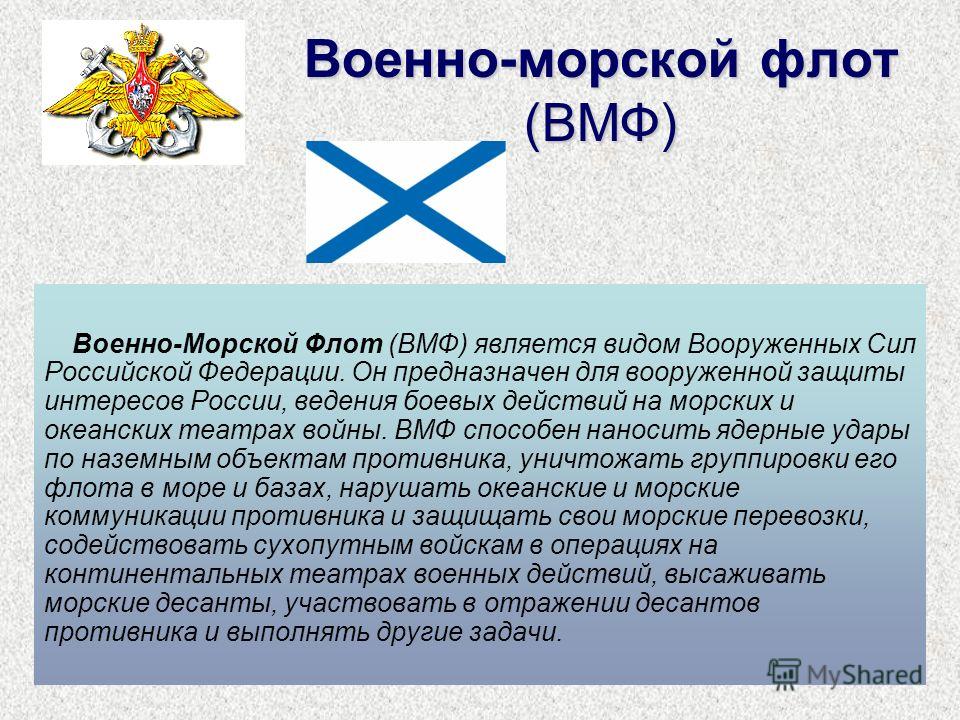
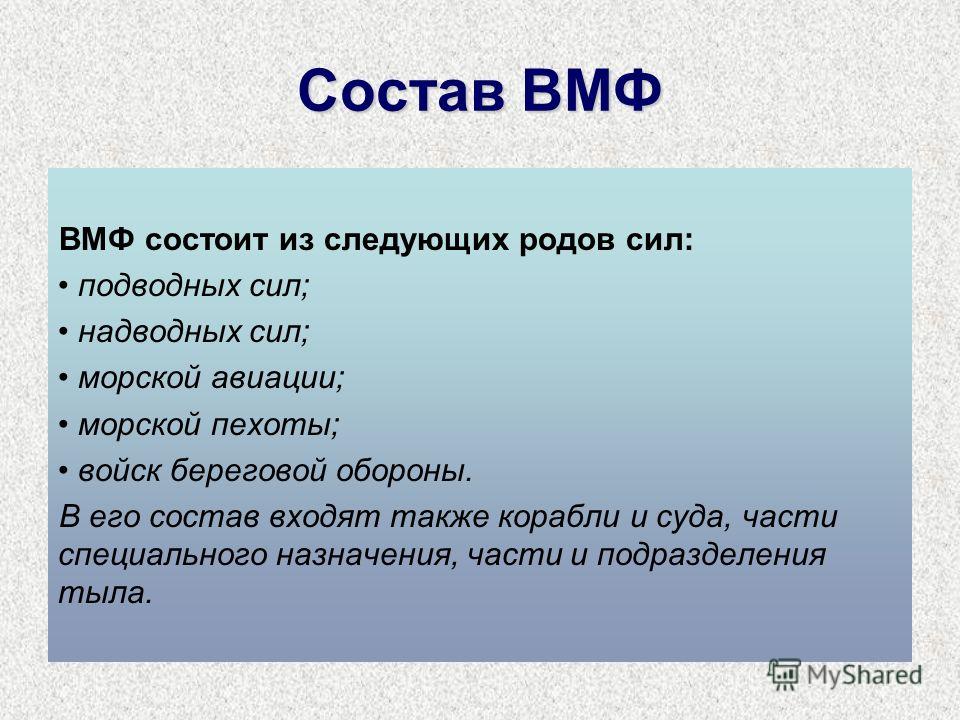
Submarine forces are the strike force of the fleet, capable of controlling the expanses of the World Ocean, covertly and quickly deploying in the right directions and delivering unexpected powerful strikes from the depths of the ocean against sea and continental targets. Depending on the main armament, submarines are divided into missile and torpedo, and according to the type of power plant, nuclear and diesel-electric. The main striking force of the Navy is nuclear submarines armed with ballistic and cruise missiles with nuclear warheads. These ships are constantly in various areas of the World Ocean, ready for the immediate use of their strategic weapons. Nuclear-powered submarines armed with ship-to-ship cruise missiles are mainly aimed at fighting large enemy surface ships.

Nuclear torpedo submarines are used to disrupt enemy submarine and surface communications and in the defense system against underwater threats, as well as to escort missile submarines and surface ships. The use of diesel submarines (missile and torpedo) is associated mainly with the solution of typical tasks for them in limited areas of the sea. Equipping submarines with nuclear power and nuclear missile weapons, powerful sonar systems and high-precision navigation weapons, along with comprehensive automation of control processes and the creation of optimal living conditions for the crew, has significantly expanded their tactical properties and forms of combat use.

Surface forces in modern conditions remain the most important part of the Navy. The creation of ships carrying aircraft and helicopters, as well as the transition of a number of classes of ships, like submarines, to nuclear power have greatly increased their combat capabilities. Equipping ships with helicopters and aircraft significantly expands their capabilities to detect and destroy enemy submarines. Helicopters create an opportunity to successfully solve the problems of relaying and communications, target designation, transfer of cargo at sea, landing troops on the coast and rescuing personnel. Surface ships are the main forces to ensure the exit and deployment of submarines to combat areas and return to bases, transport and cover landings. They are given the main role in the setting of minefields, in the fight against the mine danger and the protection of their communications.

The traditional task of surface ships is to strike at enemy targets on its territory and cover its coast from the sea from the enemy's naval forces. Thus, a complex of responsible combat missions is assigned to surface ships. They solve these tasks in groups, formations, associations both independently and in cooperation with other branches of the fleet forces (submarines, aviation, marines).

Naval aviation is a branch of the Navy. It consists of strategic, tactical, deck and coastal. Strategic and tactical aviation is designed to confront groups of surface ships in the ocean, submarines and transports, as well as to deliver bombing and missile strikes against enemy coastal targets. Carrier-based aviation is the main striking force of the Navy's aircraft carrier formations. Its main combat missions in armed struggle at sea are the destruction of enemy aircraft in the air, the starting positions of anti-aircraft guided missiles and other enemy air defense systems, the conduct of tactical reconnaissance, etc. When performing combat missions, carrier-based aviation actively interacts with tactical aviation.

Naval aviation helicopters are an effective means of targeting a ship's missile weapons when destroying submarines and repelling attacks by enemy low-flying aircraft and anti-ship missiles. Carrying air-to-surface missiles and other weapons, they are a powerful means of fire support for marines and the destruction of enemy missile and artillery boats.
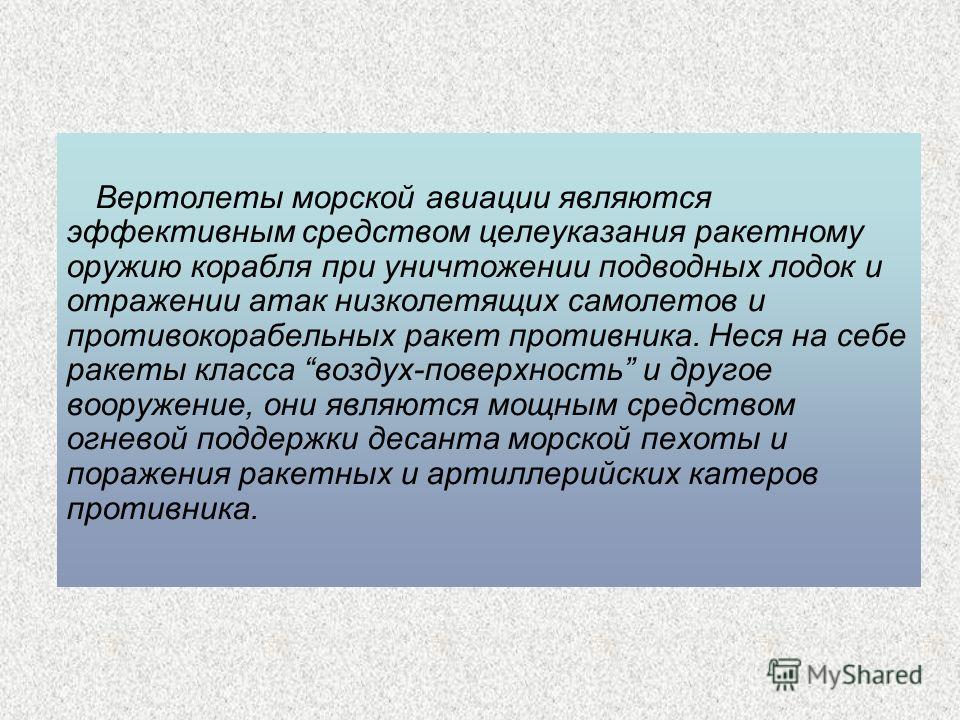
The Marine Corps is a branch of the Navy, designed to conduct combat operations as part of amphibious assault forces (independently or jointly with the Ground Forces), as well as to defend the coast (naval bases, ports). The combat operations of the marines are carried out, as a rule, with the support of aviation and artillery fire from ships. In turn, the marines use in combat operations all types of weapons characteristic of motorized rifle troops, while using landing tactics specific to it.

Coastal defense troops, as a branch of the Navy, are designed to protect naval bases, ports, important sections of the coast, islands, straits and narrownesses from enemy ships and amphibious assaults. The basis of their armament is coastal missile systems and artillery, anti-aircraft missile systems, mine and torpedo weapons, as well as special coastal defense ships (protection of the water area). Coastal fortifications are being set up on the coast to ensure defense by troops. Logistic units and subunits are intended for logistic support of the forces and military operations of the Navy. They ensure the satisfaction of the material, transport, household and other needs of formations and formations of the Navy in order to maintain them in combat readiness for the performance of assigned tasks.

Strategic Missile Forces (RVSN) Strategic Missile Forces (RVSN), a branch of the Armed Forces of the Russian Federation, the main component of its strategic nuclear forces. Designed for nuclear deterrence of possible aggression and destruction as part of strategic nuclear forces or independently massive, group or single missile and nuclear strikes of strategic objects located in one or more strategic aerospace directions and forming the basis of the military and military-economic potentials of the enemy. Space Troops The Space Troops are a fundamentally new branch of the military, which is designed to ensure Russia's security in the space sphere. The main tasks of the Space Forces are to bring information to the top military-political leadership of the country about a missile attack, missile defense of Moscow, the creation, deployment, maintenance and control of an orbital group of spacecraft for military, dual, socio-economic and scientific purposes.
 Airborne Troops The Airborne Troops (VDV), a highly mobile branch of the armed forces, designed to cover the enemy in the air and conduct combat operations in his rear. The Airborne Forces of the Russian Federation are a means of the Supreme High Command and can form the basis of mobile forces. They report directly to the commander of the Airborne Forces and consist of airborne divisions, brigades, det. parts and institutions.
Airborne Troops The Airborne Troops (VDV), a highly mobile branch of the armed forces, designed to cover the enemy in the air and conduct combat operations in his rear. The Airborne Forces of the Russian Federation are a means of the Supreme High Command and can form the basis of mobile forces. They report directly to the commander of the Airborne Forces and consist of airborne divisions, brigades, det. parts and institutions.

Airborne Troops History Airborne Troops originates on August 2, 1930, when during the exercises of the Air Force of the Moscow Military District, near Voronezh, a paratrooper unit of 12 people was parachuted. The first airborne units in the Soviet Union began to form in 1931. During that period, the first badges with the image of a parachute appeared. The first badge "Parachutist" was approved on February 12, 1931 by the decision of the Central Council of Osoaviakhim.

Logistics of the Armed Forces of the Russian Federation Logistics of the Armed Forces of the Russian Federation is an integral part of the defense potential of the state and a link between the country's economy and the troops directly consuming the products produced, it is a well-coordinated, effectively operating mechanism. It consists of the Logistics Headquarters, 9 main and central directorates, 3 services, as well as government bodies, troops and organizations central subordination, rear structures of types and branches of troops of the Armed Forces, military districts and fleets, associations, formations and military units. Equipment modern designs material and technical means allows the rear structures to provide the troops in a timely manner and in full with everything necessary for them to solve complex and responsible tasks related to maintaining the state's defense capability at the proper level.

Main Military Medical Department of the Ministry of Defense of the Russian Federation Main Department of Trade of the Ministry of Defense of the Russian Federation Central Clothing Department of the Ministry of Defense of the Russian Federation Agriculture of the Ministry of Defense of the Russian Federation

The Armed Forces of the Russian Federation (RF Armed Forces) include: Ground Forces (SV), Air Force (Air Force), Navy (Navy), branches of service (Strategic Missile Forces, Space Forces, Airborne Forces) , as well as the Logistics of the Armed Forces. The types of troops are divided into types of troops (aircraft branches in the Air Force, branches of forces in the Navy) and special troops.
Ground troops are a type of troops designed to conduct combat operations on land.
In terms of their combat capabilities, they are capable of conducting an offensive in order to defeat enemy troops and seize his territory, deliver fire strikes to a great depth, repel an enemy invasion, and firmly hold occupied territories and lines. The Ground Forces include: motorized rifle, tank, missile troops and artillery, air defense troops, army aviation, as well as units and subunits of special troops, units and institutions of the rear.
The Air Force is a branch of the Armed Forces designed to strike at enemy air, land and sea groups, its administrative, political, industrial and economic centers in order to disrupt state and military administration, disrupt the rear and transport, as well as conduct aerial reconnaissance and air transportation. They can perform these tasks in any weather conditions, time of day and year.
In accordance with the combat missions and the nature of the actions, aviation is divided into types: bomber, fighter-bomber, fighter, assault, reconnaissance, anti-submarine, military transport and special.
Aircraft units are armed with aircraft, seaplanes and helicopters. The basis of the combat power of the Air Force is supersonic all-weather aircraft equipped with a variety of bomber, missile and small arms and cannon weapons.
The Navy is a branch of the Armed Forces, which is designed to strike at industrial and economic regions (centers), important military targets of the enemy and defeat his naval forces. The Navy is capable of inflicting nuclear strikes on enemy ground targets, destroying its fleet at sea and bases, disrupting its ocean and sea communications and defending its own, assisting ground forces in conducting operations, landing amphibious assaults and repulsing enemy amphibious landings, transporting troops, materiel and perform other tasks.
The Navy consists of branches of forces: underwater, surface, naval aviation, coastal missile and artillery troops and marines. It also includes ships and vessels of the auxiliary fleet, special forces and various services. The main branches of forces are submarine forces and naval aviation.
The Strategic Rocket Forces were created in 1960. They are equipped with nuclear missile weapons and are designed to carry out strategic missions. Rocket troops are distinguished by:
Huge striking power;
High combat readiness and accuracy of nuclear missile strikes;
Virtually unlimited range;
The ability to strike simultaneously on many objects, successfully overcome the opposition of air defense and missile defense, to carry out assigned tasks in the shortest possible time;
Possibility of wide maneuver with nuclear missile strikes;
Independence of combat use from weather conditions, time of year and day.
They are armed with stationary and mobile missile systems.
The space forces carry out the tasks of detecting ballistic missile launches and warning of a missile attack. They launch launch vehicles, control the orbital constellation of spacecraft and maintain it at a level that allows solving problems in peacetime and wartime. The airborne troops are an independent branch of the armed forces, intended for combat operations behind enemy lines. They consist of airborne, tank, artillery, self-propelled artillery and other units and subunits, as well as units and subunits of special forces and rear. The main combat properties of the Airborne Forces: the ability to quickly reach remote areas, deliver surprise strikes, and successfully conduct combined arms combat.
The rear of the Armed Forces is the forces and means that provide logistic and technical support to the army and navy in peace and war time. It also performs the functions of a link between the country's economy and the troops. The Logistics includes various units, institutions and subunits necessary to solve the following tasks: to constantly maintain stocks of materiel and provide troops with them; to carry out preparation, operation, technical cover and restoration of communication lines and vehicles; provide military transportation of all types; restore military equipment and property; create conditions for basing aviation and naval forces; render medical care to the wounded and sick, to carry out anti-epidemic, treatment-and-prophylactic, sanitary-hygienic and veterinary measures; to carry out commercial, household, apartment-operational and financial support; assist troops in restoring their combat readiness and eliminating the consequences of enemy strikes. To accomplish these tasks, the Rear has bases and warehouses with stocks of materiel for various purposes, special troops (railway, automobile, road and pipeline), an auxiliary fleet, engineering, airfield, aviation technical, repair, medical, veterinary and other units, subdivisions and institutions.
Special Forces consist of military units and subunits designed to perform special tasks to ensure the combat and daily activities of the Armed Forces. The Armed Forces of the Russian Federation have special troops directly subordinate to the Ministry of Defense, as well as being part of the types of the Armed Forces and Logistics. The name, composition, organization, armament and technical equipment of the formations of these troops are determined by their purpose. In most types of aircraft, these include: engineering troops, signal troops, troops of radiation, chemical and biological protection, radio engineering units and topographic and geodetic units. The Logistics of the Armed Forces includes such special troops as automobile, road, rail, pipeline, etc. Some types of the Armed Forces have special troops peculiar only to them, for example, the Air Force - parts of the engineering and aviation service.
>>OBZHD: Organizational structure of the Armed Forces. Types of Armed Forces
Organizational structure. Armed Forces. Types of the Armed Forces, kind, troops.
Ensuring the military security of the Russian Federation is the most important direction of the state's activity. The military organization of the state serves the purpose of ensuring the military security of the Russian Federation. The military organization of the state includes Military establishment of the Russian Federation, constituting its core, and other troops, military formations and bodies designed to perform military security tasks by military methods, as well as their command and control bodies.
The Armed Forces of the Russian Federation consist of central bodies of military command, associations (military districts, fleets, armies, flotillas, corps), formations (divisions, brigades), military units and organizations that are part of the types and types of troops, in the rear of the Armed Forces.
The personnel of the Russian Armed Forces includes servicemen and civilian personnel.
The leadership of the Armed Forces is exercised by the President of the Russian Federation, who, in accordance with the Constitution, is the Supreme Commander-in-Chief of the Armed Forces of the Russian Federation.
The President of the Russian Federation has been granted the right, in the event of aggression or a direct threat of aggression, to impose martial law on the territory of the country. The President, as the Supreme Commander-in-Chief, within the limits of his authority, may issue orders and directives binding on the Armed Forces of the Russian Federation, other troops, military formations and bodies.
The Armed Forces of the Russian Federation are controlled by the Minister of Defense through the Ministry of Defense and the General Staff of the Armed Forces.
Currently, the Armed Forces of the Russian Federation consist of three types of troops: the Ground Forces, the Air Force, the Navy - and three types of troops: Missile troops strategic purpose, Airborne Troops, Space Troops.
The history of the creation of branches of the Armed Forces is connected with the methods of conducting armed struggle and the space in which it is conducted: on land, sea, and in the air.
At the beginning of the history of Russia, the armed struggle for the independence of the state was carried out only on land, so the main type of the Armed Forces was the ground forces. The prototype of the ground forces was the princely squad Kievan Rus. At first, the ground forces had two types of troops: cavalry and infantry.
In the XVI century. Artillery appears in the armed forces of the Muscovite State, and another branch of the military is born.
The improvement of the ground forces took place as a centralized state was formed, the economic and economic way of life of the country was strengthened.
At the end of the XVII-beginning of the XVIII century. during the reign of Peter I, Russia went to the sea, it became necessary to create a new type of armed forces - the navy for the interests of Russia in the sea. Under Peter I, the Russian navy began to be created.
During the winter of 1695/96 near Voronezh on the Don, near Moscow on the Oka, in other cities and villages, hundreds of rowboats and two sailing ship Apostle Peter and Apostle Paul. Appearing near Azov, the Russian fleet provided Peter I with a decisive advantage in forces, and the Turkish fortress fell. Impressed by this victory, the Boyar Duma on October 30, 1696 decided: "There will be sea vessels." Since that date, the Russian fleet has been counting down its official history.
By the end of the 30s. in the USSR, a large modern industry was created, which made it possible to produce all types of weapons, including submarines and large submarines of all classes.
In 1936, the Soviet government decided to create a large sea and ocean fleet in the USSR.
At the beginning of the XX century. in Russia, the first aviation enterprises appeared, where aircraft and engines of domestic and foreign designs were assembled. In 1909-1910. formation of military aviation units. Russian pilots received their first baptisms of fire during the Balkan War (1912-1913). Then the Russian aviation corps operated on the side of Bulgaria.
By the beginning of the First World War, Russia already had 39 detachments, which included 263 aircraft. In 1914, the world's first Ilya Muromets heavy bomber, capable of carrying up to 500 kg of bombs, entered service with the Russian army.
During the First World War, aviation turned from an auxiliary means of reconnaissance and communications into an independent branch of the military. This was the beginning of the branch of the Armed Forces - the Air Force.
The use of aviation for reconnaissance and bombing in local wars of 1911-1913. in Europe led to the creation in a number of countries special means to destroy aircraft in the air. So, in 1911, for this purpose, a machine gun was installed on the aircraft.
The Air Force took an active part in the First World War and the Civil War (on both sides). After graduation civil war improved the structure of the Air Force. Since 1927, the formation of aviation brigades has begun. In 1933, bomber aviation corps were created. By the middle of 1941, the Air Force consisted of 53.4% of fighters, 41.4% of bombers and attack aircraft, 3.2% of reconnaissance aircraft, and 2% of auxiliary aircraft.
In World War II, the struggle for air supremacy was an integral and integral part of the entire armed struggle on the Soviet-German front. Its important stages were the active actions of Soviet aviation during the battles near Moscow and Stalingrad, in the Kuban and the Kursk salient. By the middle of 1943, strategic air supremacy had been firmly won and was maintained until the end of the war.
During the years of the Great Patriotic War The Soviet Air Force carried out more than 3 million sorties. 48,000 enemy planes were destroyed in the air and at airfields.
About 200 thousand Soviet pilots were awarded orders and medals during the war years, 2420 were awarded the title of Hero Soviet Union, including 29 Soviet military pilots. 65 pilots were awarded this title twice, and A. I. Pokryshkin and I. N. Kozhedub - three times.
During the First World War, air defense was created in all the warring states.
In November 1914, the creation of an air defense system for the country's capital, Petrograd, began in Russia. To protect the city from enemy aircraft and airships, subunits were formed that were armed with fortress and field artillery guns adapted for firing at air targets. Air cover for the capital was carried out by four aircraft of the Gatchina aviation school. Observation posts were set up to detect an air enemy.
In March 1915, the first automobile battery for firing at air targets was formed in Tsarskoye Selo, armed with special anti-aircraft guns.
The registration of the Air Defense Forces as an independent branch of the Armed Forces took place during the Great Patriotic War on November 9, 1941 by a resolution of the State Defense Committee "On strengthening and strengthening the air defense of the Union territory."
In 1949, the first Soviet atomic charge was detonated in the Soviet Union. This is how nuclear weapons appeared, and the question arose about the means of delivering them to targets. By the end of the 50s. The first intercontinental ballistic missile systems and medium-range strategic missiles capable of carrying a nuclear charge began to enter service with the Soviet troops.
In 1960, an independent branch of the Armed Forces was created - the Strategic Missile Forces (RVSN). Organizationally, the Strategic Missile Forces consisted of missile armies and divisions, training grounds, military educational institutions, enterprises and institutions. Immediately after the creation of the Strategic Missile Forces, two main tasks which they had to decide: how to carry out an immediate successful launch of missiles in any situation and how to simultaneously ensure the nuclear security of the country and the world.
The development of means of armed struggle, the creation of new types of weapons and military technology, the use of which made it possible to conduct combat operations not only on land, but also at sea, in the air and in space, contributed to the formation in the Armed Forces of special types of armed forces and military branches. Armed Forces of the Soviet Union since the beginning of the 60s. had five branches of the Armed Forces: the Strategic Missile Forces (RVSN), the Ground Forces (SV), the Air Defense Forces (Air Defense Forces), the Air Force (Air Force), and the Navy (Navy). The Armed Forces of the Russian Federation inherited this structure, but since 1998 the Air Defense Forces became part of the Air Force and the Armed Forces of the Russian Federation switched to a four-service structure (RVSN, SV, Air Force and Navy), and in 2002 - to a three-service structure (SV, Air Force and the Navy), while the Strategic Missile Forces, the Space Forces and the Airborne Forces were transformed into independent branches of the military.
Ground Forces (SV)
Ground Forces - a branch of the Armed Forces of the Russian Federation, designed to cover the State Border, repel attacks by an aggressor, hold the occupied territory, defeat groupings of troops and capture enemy territory. Equipped various types military equipment and weapons, they include military command and control bodies, motorized rifle, tank troops, missile troops and artillery, air defense troops (Air Defense), which are military branches, as well as special troops (reconnaissance formations and units, communications, electronic warfare, engineering, RCB- protection, nuclear-technical, technical support, automobile and rear protection), military units and rear services, other military units, institutions, enterprises and organizations. Combat vehicles and armament of the SV are presented on a colored insert (photo 8-16).
Motorized rifle troops are capable of operating both in the conditions of the use of conventional weapons and nuclear weapons. Motorized rifle troops can break through the enemy's prepared defenses, develop an offensive at a high rate and to great depths, destroy the enemy together with other branches of the military, and consolidate and hold the occupied terrain.
Tank troops constitute the main strike force of the Ground Forces. They have great resistance to the damaging factors of nuclear weapons, they are used mainly in the main directions in defense and offensive. Tank troops are capable of making fullest use of the results of fire strikes and achieving the final objectives of a battle and operation in a short time.
Rocket troops and artillery are the main means of nuclear and fire destruction of the enemy in front-line, army (corps) operations and combined arms combat.
The Air Defense Troops of the Ground Forces (Air Defense Forces) are designed to cover a group of troops, facilities and their rear from enemy air strikes. They are capable of destroying enemy aircraft and unmanned air assault vehicles on their own and in cooperation with the Air Force forces and means, combat enemy airborne assaults on their flight routes and during their release, conduct radar reconnaissance and notify troops of the threat of an air attack.
Engineer Troops - special troops intended for engineering reconnaissance of terrain and objects, fortification equipment of areas where troops are located, construction of barriers and demolition, making passages in engineering barriers, mine clearing of terrain and objects, preparation and maintenance of movement and maneuver routes, equipment and maintenance of crossings during overcoming water barriers, equipment of water supply points.
Air Force (Air Force)
The Air Force is a type of the Armed Forces designed to protect the organs of the highest state and military administration, strategic nuclear forces, groupings of troops, important administrative and industrial centers and regions of the country from reconnaissance and air strikes, to gain air supremacy, fire and nuclear defeating the enemy from the air, increasing mobility and ensuring the actions of formations of the branches of the Armed Forces, conducting integrated reconnaissance and performing special tasks (insert, photo 17-19). The Russian Air Force consists of associations, formations and military units and includes types of aviation: long-range, military transport, front-line (it includes bomber, attack, fighter, reconnaissance aviation), army, as well as types of anti-aircraft troops: anti-aircraft missile troops, radio engineering troops.
Long-range aviation is the main strike force of the Air Force, capable of effectively hitting important targets of aviation groups, ships carrying sea-based cruise missiles (SLCMs), energy facilities and facilities of the highest military and government controlled, nodes of railway, automobile and sea communications.
Military transport aviation is the main means of landing troops and military equipment in the interests of operations in the continental and oceanic theaters of war, it is the most mobile means of delivering materiel, military equipment, food, units and subunits of various types of the Armed Forces and military branches to specified areas.
Front-line bomber and attack aviation is intended primarily for air support of the Ground Forces in all types of military operations (defense, offensive, counteroffensive). Frontal reconnaissance aviation is designed to conduct aerial reconnaissance in the interests of all branches of the Armed Forces and combat arms. Front-line fighter aircraft are designed to destroy enemy air attack weapons while solving the tasks of providing cover for groupings of the Armed Forces, economic regions, administrative and political centers, military and other facilities.
Army aviation is intended for fire support of the Ground Forces. It is also entrusted with the tasks of combat and logistics support. In the course of a battle, army aviation strikes at enemy troops, destroys his airborne assault forces, raiding, forward and outflanking detachments; ensures the landing and air support of its landing forces, fights enemy helicopters, destroys its nuclear missiles, tanks and other armored equipment.
Anti-aircraft missile troops are designed to cover troops and facilities from enemy air attacks.
Radio engineering troops are designed to detect enemy air attack means in the air, identify them, escort them, alert command, troops and bodies about them. civil defense, to control the flights of their aviation.
Navy (Navy)
The Russian Navy is a branch of the Armed Forces designed to ensure the military security of the state from oceanic (maritime) directions, to protect the strategic interests of the Russian Federation in oceanic, maritime areas (zones) (insert, photo 20-22).
The Russian Navy consists of four fleets (Northern, Pacific, Baltic and Black Sea) and the Caspian Flotilla and includes the types of forces: submarine forces, surface forces, naval aviation, coastal troops (motorized rifle, tank formations and units, marines and coastal rocket and artillery troops ), parts and subdivisions of support and maintenance.
The basis of the Northern and Pacific Fleets are strategic missile submarines and multi-purpose nuclear submarines, diesel submarines, aircraft carriers, rocket-artillery, landing ships and boats, naval, missile-carrying and anti-submarine aviation.
The basis of the Baltic, Black Sea Fleets and the Caspian Flotilla are multi-purpose surface ships, mine-sweeping ships and boats, diesel submarines, coastal missile and artillery troops and attack aircraft.
Submarine forces are designed to destroy enemy ground targets, search for and destroy enemy submarines, strike at groups of surface ships, including aircraft carriers, naval strike groups, landing detachments and convoys, both independently and in cooperation with other forces of the fleet. .
The surface forces are designed to search for and destroy submarines, to fight against surface ships, to land amphibious assault forces on the enemy coast, to detect and neutralize sea mines, and to perform a number of other tasks.
Naval aviation is designed to destroy ship groups, convoys, enemy landings at sea and in bases; to search for and destroy enemy submarines, to disrupt its surveillance and control systems in maritime theaters; to cover groupings of their ships, conduct reconnaissance and issue target designations in the interests of using weapons by naval forces.
Coastal troops are intended for operations in amphibious assaults, defense of the country's coast and important objects of the fleet (front) on the coast and coastal communications from attacks by enemy fleet forces.
Strategic Rocket Forces (RVSN)
The Strategic Missile Forces are an independent branch of the military, designed to implement nuclear deterrence measures and destroy strategic targets that form the basis of the enemy's military and military-economic potential.
Organizationally, the Strategic Missile Forces consist of missile armies and divisions, a training ground, military educational institutions, enterprises and institutions.
Modern Strategic Rocket Forces embody the achievements of advanced design and engineering. In many respects, domestic missile systems, command and control systems for troops and nuclear missile weapons are unique and have no analogues in the world.
The basis of the armament of the Strategic Missile Forces are stationary and mobile (ground and railway) missile systems. Stationary complexes in terms of the number of launchers make up about 45% of the total number of combat missile systems, and in terms of the number of warheads - almost 75% of the existing grouping. The vast majority of their missiles are liquid-propellant, equipped with multiple warheads.
Combat duty is the highest form maintaining the combat readiness of the troops and weapons of the Strategic Missile Forces (insert, photo 6, 7).
Airborne Troops (VDV)
The airborne troops are a highly mobile independent branch of the military, designed to cover the enemy by air and perform tasks in his rear.
The airborne troops are capable of solving operational and tactical combat missions independently or as part of the Ground Forces groupings both in a large-scale war and in local conflicts. Being a highly mobile branch of the armed forces, 95% consisting of units of constant readiness, the Airborne Forces or their separate units can be used as paratroopers behind enemy lines.
The Airborne Troops include: four divisions, 242 training centers, the Ryazan Institute of the Airborne Forces, the 31st Separate Airborne Brigade (OVDBr), as well as support and maintenance units.
The airborne troops, whose motto is "No one but us!", Have always been considered the army elite, and service in them is prestigious, but the most difficult.
The Airborne Forces, in addition to BMD (airborne combat vehicle) of various classes, are equipped with 120-mm self-propelled artillery guns, 122-mm howitzers, armored personnel carriers with ATGMs, anti-aircraft artillery mounts and MANPADS, automatic and manual anti-tank grenade launchers, modern small arms . All equipment and weapons of the Airborne Forces can be parachuted by military transport aircraft IL-76 and An-22.
Space Forces (KV)
In accordance with the Decree of the President of the Russian Federation dated March 24, 2001, on June 1, 2001, the Space Forces were formed and began to carry out tasks for their intended purpose.
The Space Forces are a fundamentally new independent branch of the military, which is designed to reveal the beginning of a missile attack on the Russian Federation and its allies; combating enemy ballistic missiles attacking the defended area; maintaining in the established composition of orbital constellations of military and dual-use spacecraft and ensuring the use of spacecraft for their intended purpose; control of outer space; ensuring the implementation of the Federal Space programs Russia, international cooperation programs and commercial space programs.
- Menu for a month of body drying for girls
- Learning to perform an extension of the arms on the block
- How to treat the liver in adults: a list of effective drugs
- How to meet a girl
- How to pump up the press at home
- Training the rear deltas on the horizontal bar
- Is it possible to pump up the chest on the horizontal bar: an overview of effective exercises
- Recovery after dislocation of the shoulder joint: exercises, massage
- Shoulder exercises at the gym
- Drying the body: menu, stages and rules of nutrition
- What country did the ice cream come from
- The rainforest is a very special forest.
- Lecture: Structure and water masses of the World Ocean Topic "Horizontal structure of the waters of the World Ocean"
- How do Anglicans pray with two or three fingers?
- What is Anglicanism definition
- Methods for determining the coordinates of the center of gravity How to determine the center of gravity of irregularly shaped bodies
- The positions of the center of gravity of some figures How to find the center of gravity of a circle with a hole
- About the "winter" king, the beautiful princess and their castle
- How to create a rainbow at home - presentation
- Why is biology needed?









